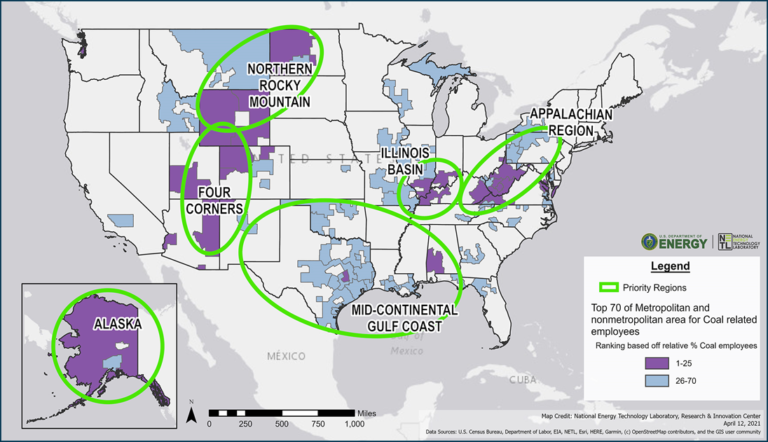Priority Energy Communities
United States coal mining employment fell from more than 175,000 in 1985 to roughly 40,000 in 2020, with close to 15% of remaining workers now at or approaching retirement age. That’s why the Interagency Working Group is focusing initial federal investments in areas with high concentrations of coal-dependent jobs.
As the Interagency Working Group is prioritizing the immediate needs of coal mining and power plant communities, the Working Group also is coordinating, identifying, and delivering federal resources to all Energy Communities, fenceline communities and Tribal communities.
The Working Group is prioritizing the following coal and powerplant communities in the near-term for investment using existing federal agency programs and funding from the FY2021 budget and American Rescue Plan.
| Rank | Bureau of Labor Statistics Area Name |
|---|---|
| 1 | Southern West Virginia non-metropolitan area |
| 2 | East Kentucky non-metropolitan area |
| 3 | Wheeling, West Virginia-Ohio |
| 4 | Southwest Virginia non-metropolitan area |
| 5 | Alaska non-metropolitan area |
| 6 | West Kentucky non-metropolitan area |
| 7 | Bremerton-Silverdale, Washington |
| 8 | Eastern Wyoming non-metropolitan area |
| 9 | Western Wyoming non-metropolitan area |
| 10 | Arizona non-metropolitan area |
| 11 | Northern West Virginia non-metropolitan area |
| 12 | South Illinois non-metropolitan area |
| 13 | Central Utah non-metropolitan area |
| 14 | Southern Indiana non-metropolitan area |
| 15 | California-Lexington Park, Maryland |
| 16 | Farmington, New Mexico |
| 17 | Northeast Virginia non-metropolitan area |
| 18 | West North Dakota non-metropolitan area |
| 19 | Greeley, Colorado |
| 20 | College Station-Bryan, Texas |
| 21 | Southwest Alabama non-metropolitan area |
| 22 | Grand Junction, Colorado |
| 23 | Beckley, West Virginia |
| 24 | Charleston, West Virginia |
| 25* | Western Pennsylvania non-metropolitan area |
* Added for geographic diversity.
The top 25 BLS areas associated with key coal occupations.
Ranking is shown in order of % of total direct coal jobs relative to all employees for each BLS area.
The Interagency Working Group will conduct further analysis to identify additional Energy Communities and evaluate federal progress toward spurring economic revitalization. Factors to be considered include:
Employment data, including employment data from sectors providing support services to traditional energy sectors and revenue data from Energy Communities’ state and local governments.
Metrics of community economic need, including demographic data, poverty data, area median income data, health outcomes, incarceration rates, and educational attainment.
Cumulative impact data, including community-level data of relative air and water pollution levels, resilience, and climate risk exposure.
Economic development and diversification pathways, including an inventory of local assets available for economic development, an infrastructure needs analysis, and an assessment of the training needs of displaced workers.

 )
or https:// means you’ve safely connected to
the .gov website. Share sensitive information only on official,
secure websites.
)
or https:// means you’ve safely connected to
the .gov website. Share sensitive information only on official,
secure websites.

